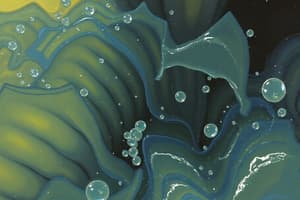Podcast
Questions and Answers
What factor does NOT influence drug formulation and bioavailability?
What factor does NOT influence drug formulation and bioavailability?
- Salt form
- Disease state (correct)
- Particle size
- Crystal polymorphism
Which type of drug transport involves the movement of drugs based on their concentration gradient?
Which type of drug transport involves the movement of drugs based on their concentration gradient?
- Active transport
- Facilitated diffusion
- Passive diffusion (correct)
- Filtration
What is the significance of the blood-brain barrier in drug administration?
What is the significance of the blood-brain barrier in drug administration?
- It is only penetrable by high molecular weight substances.
- It allows all drugs to freely enter the brain.
- It acts as a selective filter for drug absorption. (correct)
- It prevents any substance from entering the brain.
Which process is exemplified by the reabsorption of glucose in the kidneys?
Which process is exemplified by the reabsorption of glucose in the kidneys?
How do membranes permit the passage of certain chemicals during filtration?
How do membranes permit the passage of certain chemicals during filtration?
What type of barrier must drugs overcome to enter the systemic circulation?
What type of barrier must drugs overcome to enter the systemic circulation?
Which of the following statements about facilitated diffusion is accurate?
Which of the following statements about facilitated diffusion is accurate?
What is a notable characteristic of passive diffusion?
What is a notable characteristic of passive diffusion?
What primarily affects the bioavailability of a drug?
What primarily affects the bioavailability of a drug?
Which statement about first pass hepatic metabolism is true?
Which statement about first pass hepatic metabolism is true?
What characteristic is essential for a drug to readily cross the Blood Brain Barrier (BBB)?
What characteristic is essential for a drug to readily cross the Blood Brain Barrier (BBB)?
Which factor is NOT influential in drug absorption?
Which factor is NOT influential in drug absorption?
For optimal absorption, a drug should ideally be:
For optimal absorption, a drug should ideally be:
What process allows for the movement of drugs from cerebrospinal fluid (CSF) into the blood?
What process allows for the movement of drugs from cerebrospinal fluid (CSF) into the blood?
Which location is identified as the major site of drug absorption?
Which location is identified as the major site of drug absorption?
Which of the following barriers can limit drug penetration and concentration in specific tissues?
Which of the following barriers can limit drug penetration and concentration in specific tissues?
What consequence does chemical instability have on drug absorption?
What consequence does chemical instability have on drug absorption?
How does cerebrospinal fluid help in maintaining low drug concentration in the CNS?
How does cerebrospinal fluid help in maintaining low drug concentration in the CNS?
What is the primary mode of drug transfer across the placenta?
What is the primary mode of drug transfer across the placenta?
Which of the following statements is true regarding hydrophilic and hydrophobic drugs?
Which of the following statements is true regarding hydrophilic and hydrophobic drugs?
Which situation would most likely reduce the extent of drug absorption?
Which situation would most likely reduce the extent of drug absorption?
Which statement about hydrophilic drugs is true?
Which statement about hydrophilic drugs is true?
What type of drugs primarily bind to albumin?
What type of drugs primarily bind to albumin?
What is the effect of drug-protein binding on pharmacologic effects?
What is the effect of drug-protein binding on pharmacologic effects?
Which drug elimination process is limited by drug-protein binding?
Which drug elimination process is limited by drug-protein binding?
What occurs when two drugs compete for the same plasma protein binding site?
What occurs when two drugs compete for the same plasma protein binding site?
What characterizes drugs that undergo redistribution to lower their action?
What characterizes drugs that undergo redistribution to lower their action?
How does the gastrointestinal tract affect drug distribution in ruminant species?
How does the gastrointestinal tract affect drug distribution in ruminant species?
Which factor limits the biologic response to a drug primarily?
Which factor limits the biologic response to a drug primarily?
What role does the chemical structure of a drug play in active transport?
What role does the chemical structure of a drug play in active transport?
Which of the following drugs is NOT actively transported into a specific tissue or cell?
Which of the following drugs is NOT actively transported into a specific tissue or cell?
In which scenario might pinocytosis be particularly important for drug absorption?
In which scenario might pinocytosis be particularly important for drug absorption?
Why does the oral route of drug administration generally have lower bioavailability?
Why does the oral route of drug administration generally have lower bioavailability?
What effect can the presence of food in the stomach have on drug absorption?
What effect can the presence of food in the stomach have on drug absorption?
Which route of administration places the drug directly into systemic circulation?
Which route of administration places the drug directly into systemic circulation?
What is a key characteristic of drug absorption through the intestinal route?
What is a key characteristic of drug absorption through the intestinal route?
What common misconception exists regarding the effect of blood flow on gastrointestinal (GI) absorption?
What common misconception exists regarding the effect of blood flow on gastrointestinal (GI) absorption?
Flashcards are hidden until you start studying
Study Notes
Drug Absorption
- Absorption is the process of drug movement from administration site to bloodstream.
- The rate and efficiency of absorption vary by route and dosage form; oral route often has lower bioavailability due to first-pass metabolism.
- The duodenum is the primary site for drug absorption, impacting onset and magnitude of drug action.
Factors Influencing Drug Absorption
- Bioavailability: Amount of drug reaching systemic circulation unchanged; e.g., 100 mg administered with 70 mg absorbed results in 70% bioavailability.
- First Pass Metabolism: Drugs absorbed via the GI tract may be partially metabolized by the liver, decreasing the amount reaching systemic circulation.
- Solubility: Drugs must be hydrophobic yet also soluble in aqueous solutions for effective absorption; extreme hydrophilicity or hydrophobicity hinders absorption.
- Chemical Instability: Some drugs are sensitive to gastric pH, affecting their stability and absorption (e.g., Penicillin G).
- Drug Formulation: Factors like particle size, salt form, and excipients impact dissolution and thus absorption rate and bioavailability.
Drug Passage Across Membranes
- Drugs must traverse various barriers to reach receptor sites, including the blood-brain barrier and epithelial barriers.
- Passive Diffusion: Drug movement according to concentration gradient; influenced by lipid solubility and molecular size.
- Filtration: Allows low molecular weight substances to cross membranes; demonstrated in kidney filtration.
- Facilitated Diffusion: Less common; involves specific carriers to assist drug passage, such as glucose and vitamin B12 transport.
- Active Transport: Involves specialized transport proteins; drugs can be actively absorbed against concentration gradients (e.g., iodine in the thyroid).
- Pinocytosis: Minor absorption method for larger molecules and proteins; important in the gut for larger particles.
Route of Drug Administration
- IV administration bypasses absorption process by placing drug directly into circulation.
- Oral Administration: Although it is the safest method, it has lower bioavailability due to first-pass metabolism; influenced by factors like food presence and digestive differences across species.
Binding to Plasma Proteins
- Only unbound drugs can cross cell membranes; binding is reversible and affects drug distribution and elimination.
- Acidic drugs primarily bind to albumin while basic drugs bind to alpha-1-acid glycoprotein; this binding slows pharmacologic effect onset.
- Drug-protein binding impacts elimination, particularly via glomerular filtration, as bound drugs cannot be filtered.
Drug Interactions
- Competition for binding sites on plasma proteins can increase the amount of free drug, enhancing therapeutic or toxic responses.
Interspecies Differences
- Variations in gastrointestinal tract mass among species affect interspecies drug distribution, particularly in veterinary pharmacology.
Drug Redistribution
- Redistribution refers to drug sequestration in low blood flow tissues, terminating its action; often seen in highly lipid-soluble drugs like thiopental.
CNS Distribution
- CNS drug distribution is limited by the blood-brain barrier, which consists of tight junctions in capillaries; drugs need high lipid solubility to cross.
- Active transport systems in the choroid plexus regulate organic acid and base transport, maintaining low CNS concentrations of certain drugs.
- Cerebrospinal fluid circulation continuously dilutes drug concentration in the CNS.
Transplacental Distribution
- Drugs cross the placenta primarily through simple diffusion; CNS-affecting drugs generally possess properties enabling easy placental transfer.
Barriers in Other Tissues
- Specific tissues such as the prostate, testicles, and eye have barriers that limit drug penetration, influencing drug concentration in those areas.
Studying That Suits You
Use AI to generate personalized quizzes and flashcards to suit your learning preferences.




